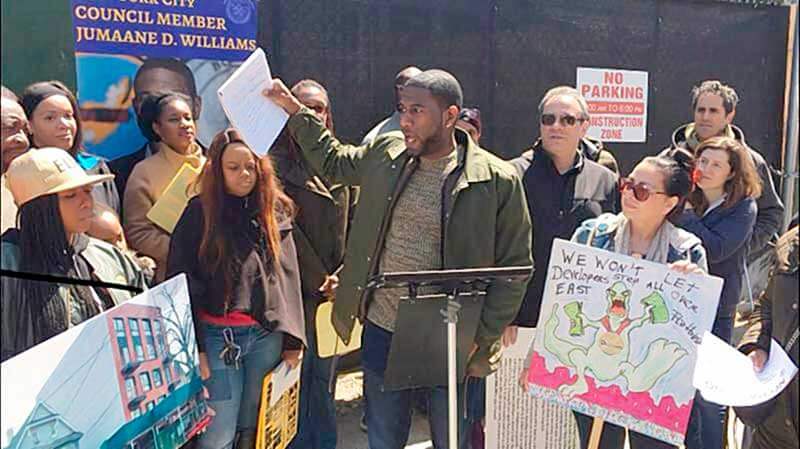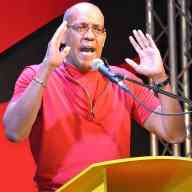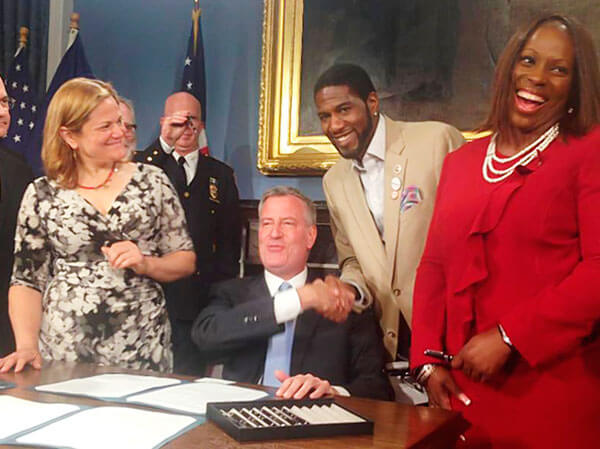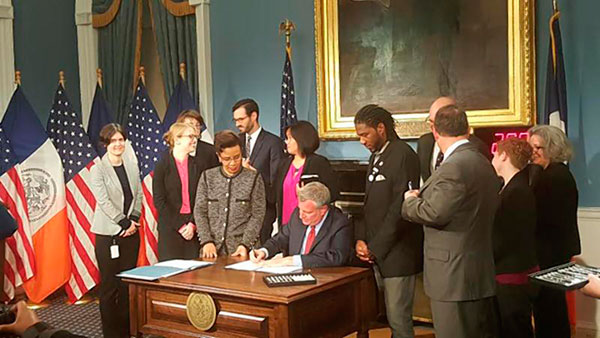ommunity groups and elected officials rallied outside a construction site in East Flatbush on Saturday, opposing what they described as over-development and predatory real estate practices, which have plagued the area in recent months.
Brooklyn Council Member Jumaane D. Williams, Deputy Leader of the City Council, led the group in speaking out and in discussing potential solutions.
The rally was held outside a construction site at 1509 New York Ave., where a single-family home was recently removed, to be replaced by a five-story multifamily home.
Williams, who represents the 45th Council District, said this is a trend within the neighborhood, and took place in the shadow of a tall, multifamily residence, which had recently replaced a single-family home.
Residents and elected officials expressed concerns that these developments were damaging the character of the long-established neighborhood.
Williams also condemned the actions of a real estate broker, “who had been intentionally misleading residents of East Flatbush regarding the zoning of the area and how their homes are affected, in an apparent attempt to encourage them to sell their property.”
The councilman said a letter was recently circulated to an unknown number of East Flatbush residents from Stephen Smith, “who identifies himself as working with Quantierra, a real estate broker’s office.
Williams said he obtained a copy of the letter, which accuses him and others of opposing “downzoning,” claiming that these community members intend to lower property values by restricting development in the area.
“The letter goes on to encourage residents to explore selling their property through Quantierra, on the false premise that their property values are in danger of imminent decline,” Williams said. “It seems to intentionally conflate ‘downzoning’ with ‘contextual zoning,’ citing a community press conference last fall” at which community and housing advocates joined Williams in condemning “fear-mongering and misleading tactics like the one used in this letter.”
Williams said contextual zoning, which advocates and elected officials pushed for at Saturday’s rally, “refers to the practice of limiting the areas where tall buildings which are drastically different from and intrusive into the neighborhoods they occupy can be constructed.
“This helps to determine areas where increased development of large multifamily buildings should occur and those where it should be limited,” he said. “The practice is intended to help preserve the character of the neighborhood and to limit unintended consequences of increased population.”
Brooklyn Assemblyman Nick Perry also spoke at the event, emphasizing that there is a way for the community and developers to work together, “if developers do not act in unscrupulous ways.”
Additional speakers included Hazel Martinez, a community activist; Corina Wong, a resident currently in a legal battle with a developer, Yves Rene, of FERN; Xamayla Rose, a community leader; Tonya Ores, of NHS Brooklyn; and Trisha Ocona, of Community Board 17.
Together, the community members and advocates presented a united voice in defense of the established neighborhood and against destructive real estate tactics, Williams said.
“We were here six months ago — and nothing has gotten better,” Williams said. “In fact, it’s gotten worse.
“Things are getting worse rapidly,” he added. “We’re losing the character of the neighborhood, and we as a community have decided we’re not going to stand idly by while it happens.
“We want to sit down with city planning, we want to sit down with the city, and discuss how to keep these blocks intact,” continued Williams, recognizing, at the same time, the need for the creation of affordable housing, a cause he’s long fought for.
“They are really about just making as much money as possible, which means that the bigger, the better, the more, the merrier.” said Perry, who represents the 58th Assembly District, of developers in the area. “The coziness and what makes this neighborhood so different, so special, is about to disappear.”


























